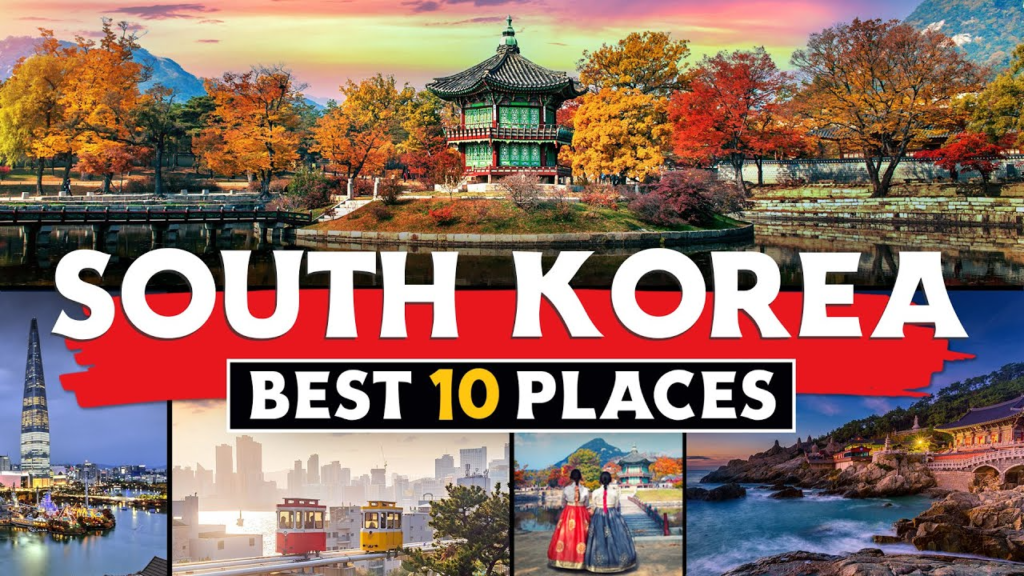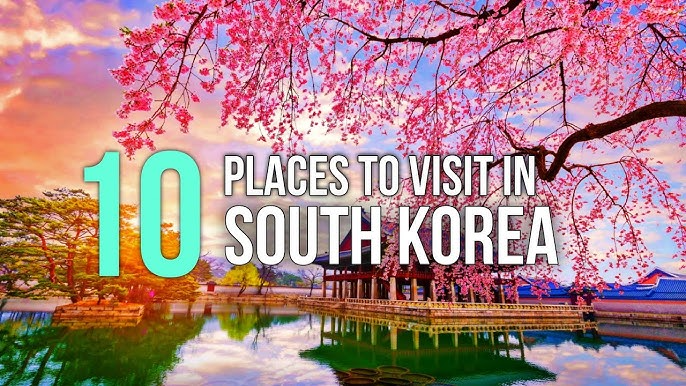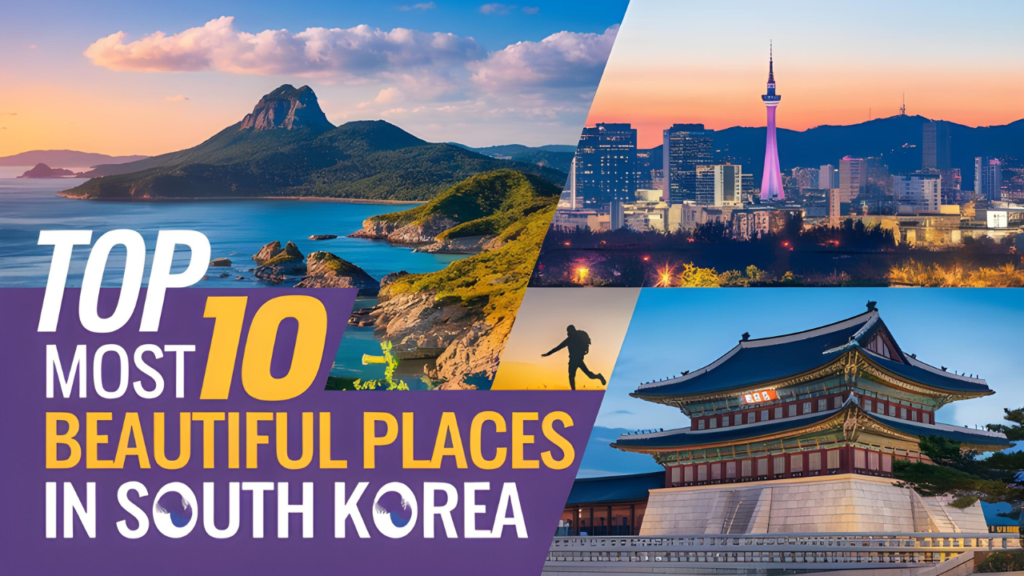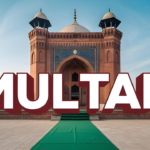South Korea, a country known for its rich history, vibrant culture, and stunning landscapes, offers a plethora of experiences for tourists. From ancient palaces and Buddhist monasteries to futuristic cities and serene national parks, South Korea has something for everyone. Whether you’re a history enthusiast, a nature lover, or a foodie, this country will not disappoint. In this article, we will explore the top 10 most beautiful places to visit in South Korea, providing you with a comprehensive guide to help you plan your trip.
Top 10 Most Beautiful Places to Visit in South Korea
South Korea is a land of contrasts, where ancient traditions meet modern innovations. The country’s diverse landscape, ranging from towering mountains to pristine beaches, combined with its rich cultural heritage, makes it a must-visit destination. Whether you’re interested in exploring historic sites, indulging in delicious cuisine, or simply relaxing in nature, South Korea has it all. Let’s dive into the top 10 most beautiful places to visit in this fascinating country.
Read More: Top 12 Most Powerful Military Forces in the World (2025)

1. Changdeokgung Palace
Changdeokgung Palace, constructed by the Joseon Dynasty in the fifteenth century, is one of Seoul’s most magnificent palaces. It was the favorite residence of the royal family and other members of the royal line. The palace complex is vast, composed of many structures, each built for a unique purpose, such as lodgings, libraries, lunchrooms, and conference halls. The Huwon, or Changdeokgung garden, spans an impressive 78 acres and is rich in Buddhist temples, ponds, and rivers, offering plenty of green spaces and walkways.
History and Architecture
Changdeokgung Palace was built as a secondary palace for the Joseon Dynasty but soon became the preferred residence due to its harmonious blend of nature and architecture. The palace is designed according to the principles of pungsu (geomancy), which emphasizes the importance of natural surroundings in creating a harmonious environment. The buildings within the complex are arranged to complement the natural landscape, creating a serene and peaceful atmosphere.
Highlights
- Injeongjeon Hall: The main throne hall where the king conducted state affairs and held important ceremonies.
- Seonjeongjeon Hall: The royal residence where the king and queen lived.
- Huwon Garden: A beautiful garden with pavilions, ponds, and walking paths, offering a tranquil escape from the bustling city.
- Daejojeon Hall: A hall used for royal banquets and entertainment.
Visitor Information
Changdeokgung Palace is open to the public, and guided tours are available to help visitors understand the historical and cultural significance of the palace. The palace is a UNESCO World Heritage Site, recognized for its outstanding universal value.
2. Busan
Busan, the second-largest city in South Korea, is a paradise for sunbathing lovers with its fantastic coastlines, stunning beaches, and luxurious hotels. Culturally and historically rich, Busan is home to the Beomeosa Temple and the mountain village of Gamcheon, known for its picturesque, European-inspired style. Don’t miss the Jagalchi Marketplace, the leading seafood market in South Korea, where you can shop for fresh seafood and have it prepared at nearby establishments.
Beaches and Coastlines
Busan’s coastlines are renowned for their beauty and offer a variety of activities for visitors. Haeundae Beach is one of the most popular beaches in South Korea, known for its clear waters and vibrant atmosphere. Gwangalli Beach is another must-visit, offering stunning views of the Gwangan Bridge, especially at night when it is illuminated.
Cultural and Historical Sites
- Beomeosa Temple: A beautiful Buddhist temple located on the slopes of Geumjeongsan Mountain, offering panoramic views of the city and the sea.
- Gamcheon Cultural Village: A charming village with colorful houses, narrow alleyways, and stunning views of the ocean. The village is known for its artistic and cultural attractions, including art galleries, cafes, and workshops.
- Yongdusan Park: A scenic park located in the heart of Busan, offering panoramic views of the city and the sea. The park is home to the Busan Tower, a popular observation deck offering breathtaking views.
Seafood Market
The Jagalchi Marketplace is a must-visit for seafood lovers. The market offers a wide variety of fresh seafood, including fish, squid, and shellfish. Visitors can shop for seafood in the open-air section of the market and have it prepared at one of the numerous nearby establishments. The market is also a great place to try local seafood dishes, such as haemul pajeon (seafood pancake) and sannakji (raw octopus).
3. Jeonju
Jeonju, a historic city that once served as the spiritual capital of the Joseon Dynasty, is about two hours from Seoul. Known for its traditional Korean village called ‘hanok,’ Jeonju offers a glimpse into Korean life from centuries past. The city is dotted with shrines, temples, and historical Korean houses, many of which are now used as eateries, hotels, and museums. Don’t miss the opportunity to explore these carefully maintained historical villages.
Hanok Village
The Jeonju Hanok Village is a living museum that showcases traditional Korean architecture and culture. The village is composed of over 800 hanok houses, many of which have been preserved or restored to their original state. Visitors can explore the narrow alleyways, traditional courtyards, and historic buildings, providing a unique glimpse into Korea’s past.
Highlights
- Gyeonggijeon Shrine: A historic shrine dedicated to the founding king of the Joseon Dynasty, Taejo.
- Jeondong Catholic Church: A beautiful Catholic church built in the traditional Korean style, blending Western and Eastern architectural elements.
- Jeonju Hyanggyo: A traditional Confucian academy that served as an educational institution during the Joseon Dynasty.
- Omokdae: A historic pavilion offering panoramic views of the city and the surrounding countryside.
Visitor Information
Jeonju is a popular tourist destination, especially during the spring and fall seasons when the weather is mild and the scenery is at its most beautiful. The city hosts various cultural festivals and events throughout the year, providing visitors with a unique and memorable experience.
4. N Seoul Tower
N Seoul Tower, standing at 500 meters tall, offers an astonishing view of the surrounding metropolis. Located near the peak of Mount Namsan, the tower is a must-visit for every tourist in Seoul. Don’t forget to explore the nearby Namsan Park and its beautiful surroundings. The tower’s upper floors feature internal and external observation decks and dining establishments, providing a breathtaking panorama of the city. At night, the tower is illuminated with unique light displays celebrating the different seasons.
History and Architecture
N Seoul Tower, originally known as the Namsan Tower, was built in 1971 as a communication and observation tower. The tower underwent a major renovation in 2005, adding new observation decks, dining establishments, and other attractions. The tower’s unique design and location make it a popular destination for both locals and tourists.
Highlights
- Observation Decks: The tower features multiple observation decks, offering panoramic views of the city and the surrounding mountains.
- N Grill: A revolving restaurant located on the top floor of the tower, offering diners a unique dining experience with stunning views.
- N Seoul Tower Plaza: A shopping and entertainment complex located at the base of the tower, featuring a variety of shops, restaurants, and attractions.
- Love Locks: A popular attraction where visitors can attach padlocks to the fence surrounding the tower, symbolizing their love.
Visitor Information
N Seoul Tower is open year-round, offering visitors a unique and memorable experience. The tower is easily accessible by public transportation, and guided tours are available for those who want to learn more about the tower’s history and attractions.

5. Bukchon Hanok Village
Bukchon Hanok Village is one of the few remaining hanok villages in Seoul, offering a unique experience of everyday life in traditional Korean settlements. These historic communities have been reconstructed using hanok dwellings from elsewhere or repaired and kept in their former locations. The village often hosts cultural displays, giving visitors a feel for South Korean history and tradition. Many of these residences are now B&Bs, offering a unique and authentic experience.
History and Architecture
Bukchon Hanok Village is located between Gyeongbokgung Palace and Changdeokgung Palace, two of Seoul’s most historic sites. The village is composed of over 900 hanok houses, many of which have been preserved or restored to their original state. The narrow alleyways, traditional courtyards, and historic buildings provide visitors with a unique glimpse into Korea’s past.
Highlights
- Traditional Hanok Houses: Explore the narrow alleyways and traditional courtyards of the hanok houses, providing a unique glimpse into Korea’s past.
- Cultural Displays: The village often hosts cultural displays, giving visitors a feel for South Korean history and tradition.
- B&Bs: Many of the hanok houses have been converted into B&Bs, offering visitors a unique and authentic experience.
- Tea Houses: Visit one of the traditional tea houses in the village, offering a variety of Korean teas and snacks.
Visitor Information
Bukchon Hanok Village is a popular tourist destination, especially for those interested in Korean history and culture. The village is easily accessible by public transportation, and guided tours are available for those who want to learn more about the village’s history and attractions.
6. Seoraksan National Park
Seoraksan National Park is a magnificent natural marvel with mountains, ponds, cascades, rivers, and extensive trekking routes. Korea’s first national park is famous for its ecological richness, home to over 1,600 varieties of wildlife and more than 1,200 types of flora. The park also houses the Baekdamsa Temple, a significant temple of the Jogye Order of Korean Buddhism. Visitors can ride the cableway up Seoraksan Mountain for breathtaking panoramas of the surroundings.
History and Ecology
Seoraksan National Park was established in 1970 as Korea’s first national park. The park is home to a diverse range of ecosystems, including mountains, forests, rivers, and wetlands. The park’s ecological richness is evident in its diverse wildlife and flora, including rare and endangered species.
Highlights
- Baekdamsa Temple: A significant temple of the Jogye Order of Korean Buddhism, offering visitors a unique and spiritual experience.
- Cableway: Ride the cableway up Seoraksan Mountain for breathtaking panoramas of the surroundings.
- Hiking Trails: Explore the park’s extensive network of hiking trails, offering visitors a unique and memorable experience.
- Wildlife and Flora: Discover the park’s diverse wildlife and flora, including rare and endangered species.
Visitor Information
Seoraksan National Park is open year-round, offering visitors a unique and memorable experience. The park is easily accessible by public transportation, and guided tours are available for those who want to learn more about the park’s history and attractions.
7. Demilitarized Zone (DMZ)
The Demilitarized Zone (DMZ) is a unique and historically significant piece of land dividing South Korea and North Korea. Established after the Korean War, the DMZ is a small territory about 4 kilometers wide, situated around 60 kilometers north of Seoul. A guided tour of the DMZ offers insight into the origin of the conflict and the present-day situation. Highlights include the Third Tunnel of Aggression, Imjingak Park, and the peaceful Nuri Park, dedicated to the memory of the evils of conflict.
History and Significance
The DMZ was established after the Korean War as a buffer zone between South Korea and North Korea. The zone is a demilitarized area, meaning that military activities are prohibited within its boundaries. The DMZ is a unique and historically significant piece of land, offering visitors a glimpse into the complex and ongoing conflict between the two countries.
Highlights
- Third Tunnel of Aggression: A tunnel dug by North Korean soldiers during the Korean War, used for surprise attacks on South Korea.
- Imjingak Park: A park dedicated to the memory of the Korean War, featuring exhibits and monuments related to the conflict.
- Nuri Park: A peaceful park dedicated to the memory of the evils of conflict, featuring a monument of birds (doves), a universal sign of peace.
- Dorasan Station: A train station located within the DMZ, symbolizing the hope for eventual reunification of the two countries.
Visitor Information
The DMZ is a unique and historically significant destination, offering visitors a glimpse into the complex and ongoing conflict between South Korea and North Korea. Guided tours are available for those who want to learn more about the DMZ’s history and significance.
8. National Museum of Korea
The National Museum of Korea in Seoul is one of the oldest museums specializing in contemporary and modern art. Established in 1945, the museum showcases a variety of Korean artistic creations, including ancient ceramics and cutting-edge multimedia displays. With over 220,000 pieces of art, the museum offers a rich cultural experience. Don’t miss the opportunity to explore short-term exhibitions highlighting the talents of up-and-coming artists.
History and Collection
The National Museum of Korea was established in 1945 as the Korean Government-General Museum. The museum has since grown to become one of the largest and most comprehensive museums in Asia, housing a vast collection of Korean art and artifacts. The museum’s collection spans a wide range of periods and styles, from ancient ceramics to contemporary multimedia displays.
Highlights
- Ancient Ceramics: Explore the museum’s collection of ancient Korean ceramics, including celadon and white porcelain.
- Contemporary Art: Discover the museum’s collection of contemporary Korean art, including paintings, sculptures, and multimedia displays.
- Short-Term Exhibitions: Explore short-term exhibitions highlighting the talents of up-and-coming artists.
- Research Facility: Visit the museum’s research facility, offering visitors a unique and educational experience.
Visitor Information
The National Museum of Korea is open year-round, offering visitors a rich cultural experience. The museum is easily accessible by public transportation, and guided tours are available for those who want to learn more about the museum’s collection and exhibitions.
9. Lotte World
Lotte World, located in the heart of Seoul, is a fun-filled amusement park complete with rides and a variety of attractions. It’s a great way to experience authentic Korean commercial style and enjoy a fun-filled day. The park features a resort, the largest cinema platform in the world, cultural exhibitions, and more. Don’t miss the Lotte Tower, South Korea’s highest structure and the world’s fifth-highest skyscraper, offering a wide variety of shops, restaurants, and a luxurious hotel.
History and Attractions
Lotte World was opened in 1989 as a theme park and has since grown to become one of the largest and most popular amusement parks in Asia. The park features a variety of rides and attractions, including roller coasters, water rides, and cultural exhibitions. The park is also home to the Lotte Tower, offering visitors a unique and memorable experience.
Highlights
- Lotte Tower: South Korea’s highest structure and the world’s fifth-highest skyscraper, offering a wide variety of shops, restaurants, and a luxurious hotel.
- Amusement Park: Enjoy a variety of rides and attractions, including roller coasters, water rides, and cultural exhibitions.
- Cinema Platform: The largest cinema platform in the world, offering visitors a unique and memorable experience.
- Cultural Exhibitions: Explore cultural exhibitions showcasing Korean history and culture.
Visitor Information
Lotte World is open year-round, offering visitors a fun-filled and memorable experience. The park is easily accessible by public transportation, and guided tours are available for those who want to learn more about the park’s attractions and history.

10. Gyeongbokgung Palace
Gyeongbokgung Palace, also known as the Palace of the North, is a massive building that has seen enormous upheaval throughout history. Originally constructed in 1395 as one of five royal palaces for the Joseon Dynasty, the palace was repeatedly attacked and devastated, only to be reconstructed around 1990. Today, visitors can explore the Gyeonghoeru Pavilion and Hyangwonjeong Lake, two of the few surviving Joseon-era edifices, offering a glimpse into Korea’s rich history.
History and Architecture
Gyeongbokgung Palace was the main royal palace of the Joseon Dynasty and served as the home of the kings, the royal family, and the government of Joseon. The palace was constructed in 1395 and served as the center of Korean politics and culture for over 500 years. The palace was repeatedly attacked and devastated during the Imjin War in the late 16th century and the Japanese occupation in the early 20th century. The palace was reconstructed around 1990 and today stands as a symbol of Korea’s rich history and cultural heritage.
Highlights
- Gyeonghoeru Pavilion: A beautiful pavilion located on an artificial island in the middle of a lake, offering panoramic views of the palace and the surrounding mountains.
- Hyangwonjeong Lake: A serene lake located within the palace complex, offering visitors a tranquil escape from the bustling city.
- Geunjeongjeon Hall: The main throne hall where the king conducted state affairs and held important ceremonies.
- National Palace Museum of Korea: A museum located within the palace complex, showcasing a variety of royal artifacts and treasures.
Visitor Information
Gyeongbokgung Palace is open year-round, offering visitors a unique and memorable experience. The palace is easily accessible by public transportation, and guided tours are available for those who want to learn more about the palace’s history and attractions.
Conclusion:
South Korea is a land of contrasts, where ancient traditions meet modern innovations. From the stunning landscapes of Seoraksan National Park to the vibrant streets of Seoul, South Korea offers a rich tapestry of experiences for tourists. Whether you’re interested in exploring historic sites, indulging in delicious cuisine, or simply relaxing in nature, South Korea has it all. We hope this comprehensive guide to the top 10 most beautiful places to visit in South Korea has inspired you to plan your trip and explore the wonders of this fascinating country.
Read More: Most Beautiful Places to Visit in South Korea
FAQs:
What are the top 10 most beautiful places to visit in South Korea?
The top 10 most beautiful places to visit in South Korea include Changdeokgung Palace, Busan, Jeonju, N Seoul Tower, Bukchon Hanok Village, Seoraksan National Park, the Demilitarized Zone (DMZ), the National Museum of Korea, Lotte World, and Gyeongbokgung Palace.
Why is Changdeokgung Palace significant?
Changdeokgung Palace is significant because it was the favorite residence of the royal family during the Joseon Dynasty. The palace complex is vast and includes many structures built for unique purposes, such as lodgings, libraries, and conference halls. The Huwon garden, spanning 78 acres, is rich in Buddhist temples, ponds, and rivers.
What can I expect to see in Busan?
In Busan, you can expect to see fantastic coastlines, stunning beaches, and luxurious hotels. Busan is also culturally and historically rich, with attractions like the Beomeosa Temple and the mountain village of Gamcheon. The Jagalchi Marketplace is a must-visit for seafood lovers.
What is the significance of Jeonju?
Jeonju is significant as it was the spiritual capital of the Joseon Dynasty. The city is known for its traditional Korean village called ‘hanok,’ offering a glimpse into Korean life from centuries past. Jeonju is dotted with shrines, temples, and historical Korean houses.
What are the highlights of N Seoul Tower?
The highlights of N Seoul Tower include its observation decks offering panoramic views of the city, the revolving restaurant N Grill, the N Seoul Tower Plaza with shops and entertainment, and the Love Locks attraction where visitors can attach padlocks symbolizing their love.
What can I experience in Bukchon Hanok Village?
In Bukchon Hanok Village, you can experience everyday life in traditional Korean settlements. The village hosts cultural displays, giving visitors a feel for South Korean history and tradition. Many of the residences are now B&Bs, offering a unique and authentic experience.
What makes Seoraksan National Park special?
Seoraksan National Park is special because it is a magnificent natural marvel with mountains, ponds, cascades, rivers, and extensive trekking routes. It is home to over 1,600 varieties of wildlife and more than 1,200 types of flora, including the Baekdamsa Temple, a significant temple of the Jogye Order of Korean Buddhism.
What is the Demilitarized Zone (DMZ)?
The Demilitarized Zone (DMZ) is a unique and historically significant piece of land dividing South Korea and North Korea. Established after the Korean War, the DMZ is a small territory about 4 kilometers wide, situated around 60 kilometers north of Seoul. It offers insight into the origin of the conflict and the present-day situation.
What can I see at the National Museum of Korea?
At the National Museum of Korea, you can see a variety of Korean artistic creations, including ancient ceramics and cutting-edge multimedia displays. The museum houses over 220,000 pieces of art, offering a rich cultural experience. Short-term exhibitions highlighting the talents of up-and-coming artists are also available.
What are the main attractions at Lotte World?
The main attractions at Lotte World include a variety of rides and attractions, such as roller coasters and water rides, cultural exhibitions, the Lotte Tower offering shops, restaurants, and a luxurious hotel, and the largest cinema platform in the world.
Why is Gyeongbokgung Palace important?
Gyeongbokgung Palace is important because it was the main royal palace of the Joseon Dynasty and served as the home of the kings, the royal family, and the government of Joseon. The palace was reconstructed around 1990 and today stands as a symbol of Korea’s rich history and cultural heritage.
What is the best time to visit South Korea?
The best time to visit South Korea is during the spring (April to June) and fall (September to November) seasons when the weather is mild and the scenery is at its most beautiful. These seasons offer pleasant temperatures and vibrant landscapes, making them ideal for sightseeing and outdoor activities.
How can I get to Changdeokgung Palace?
You can get to Changdeokgung Palace by taking the subway to Anguk Station (Line 3) and walking about 5 minutes to the palace entrance. Alternatively, you can take a taxi or bus to the palace.
What are the must-visit beaches in Busan?
The must-visit beaches in Busan include Haeundae Beach, known for its clear waters and vibrant atmosphere, and Gwangalli Beach, offering stunning views of the Gwangan Bridge, especially at night when it is illuminated.
What is the significance of the Huwon garden in Changdeokgung Palace?
The Huwon garden in Changdeokgung Palace is significant because it spans an impressive 78 acres and is rich in Buddhist temples, ponds, and rivers. The garden offers plenty of green spaces and walkways, providing a tranquil escape from the bustling city.
What can I do at the Jagalchi Marketplace in Busan?
At the Jagalchi Marketplace in Busan, you can shop for fresh seafood in the open-air section of the market and have it prepared at one of the numerous nearby establishments. You can also try local seafood dishes, such as haemul pajeon (seafood pancake) and sannakji (raw octopus).
What is the history of N Seoul Tower?
N Seoul Tower, originally known as the Namsan Tower, was built in 1971 as a communication and observation tower. The tower underwent a major renovation in 2005, adding new observation decks, dining establishments, and other attractions. The tower’s unique design and location make it a popular destination for both locals and tourists.
What can I expect to see in the Bukchon Hanok Village?
In the Bukchon Hanok Village, you can expect to see traditional Korean architecture and culture. The village is composed of over 900 hanok houses, many of which have been preserved or restored to their original state. The narrow alleyways, traditional courtyards, and historic buildings provide visitors with a unique glimpse into Korea’s past.
What are the highlights of Seoraksan National Park?
The highlights of Seoraksan National Park include the Baekdamsa Temple, a significant temple of the Jogye Order of Korean Buddhism, the cableway offering breathtaking panoramas of the surroundings, extensive hiking trails, and the park’s diverse wildlife and flora, including rare and endangered species.
What is the significance of the Demilitarized Zone (DMZ)?
The significance of the Demilitarized Zone (DMZ) lies in its role as a buffer zone between South Korea and North Korea, established after the Korean War. The DMZ is a unique and historically significant piece of land, offering visitors a glimpse into the complex and ongoing conflict between the two countries. Highlights include the Third Tunnel of Aggression, Imjingak Park, and the peaceful Nuri Park, dedicated to the memory of the evils of conflict.






